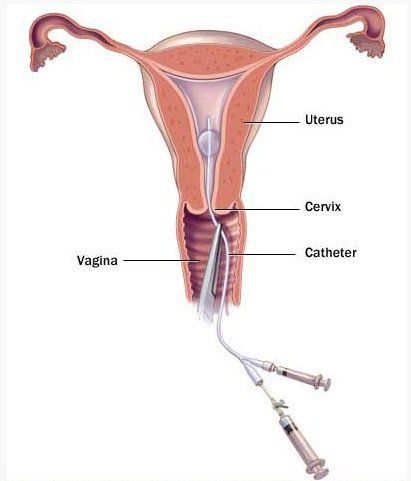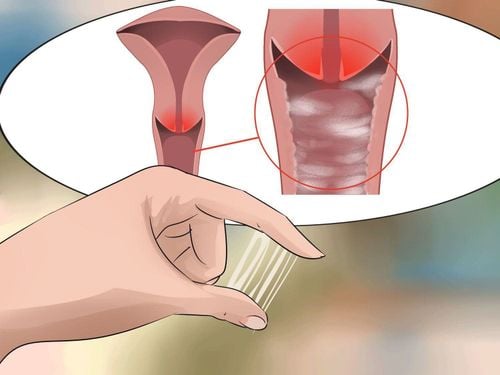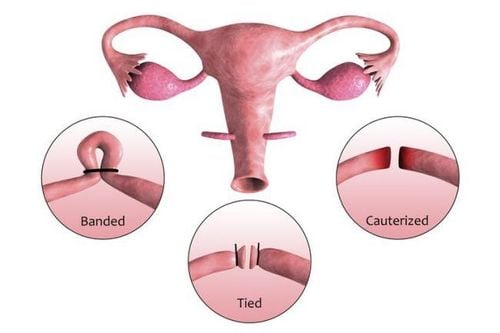This is an automatically translated article.
The article was professionally consulted by Specialist Doctor 1 Vu Thi Hanh and Doctor Pham Quoc Thanh Department of Diagnostic Imaging - Vinmec Hai Phong International General HospitalHSG is a method to check the condition of the uterus and fallopian tubes in women when they are having problems with pregnancy and childbirth. So in what specific cases should HSG be taken?
1. What is HSG?
Hysterosalpingography (abbreviated as HSG, or hysterosalpingogram) is an X-ray test used to examine the inside of the uterus and fallopian tubes.HSG is often used to diagnose partial or complete tubal occlusion. This test also detects abnormalities in the size or shape of the uterus. All of these problems can lead to infertility and other pregnancy-related disorders.
For some cases of cervical sterilization, an HSG is a necessary test to make sure that the fallopian tubes are completely closed and that you have successfully sterilized. HSG is not recommended for the following:
Pregnant Pelvic Inflammation Severe uterine bleeding at the time of the test. History of contrast allergy
2. When do you need an HSG?
If you have had intercourse and are not using birth control (such as the pill or the injection) you can have an HSG test in the first 2 weeks after your period. Specifically:
If you are trying to get pregnant, your doctor will advise you when to have an HSG. Once you have had transcervical sterilization, you should have an HSG scan 3 months later.

Tình trạng tắc ống dẫn trứng gây vô sinh
3. What should be prepared before taking HSG?
Your doctor will usually suggest you take an over-the-counter pain reliever an hour before the test. In some cases, your doctor may also prescribe an antibiotic before the HSG scan. Most cases after the HSG scan are able to drive home on their own. However, just to be on the safe side or when you're not feeling well after an HSG test, it's best to have a loved one drive you home.
4. How is the HSG scan done?
An HSG scan is usually done in a hospital, clinic, or imaging center. The best time to do an HSG test is during the first half of your menstrual cycle (from days 6-11 of your period). This is also the period when conception is rare.
During an HSG scan, a contrast medium is injected into the uterus and fallopian tubes. This is essentially a liquid containing dye. The dye will reflect body structures on an X-ray screen. The doctor will look on the screen an outline of the inside size and shape of the uterus and fallopian tubes. The doctor may also observe the dye moving to other organs.
Specifically, the HSG scan is done according to the following steps:
You will lie on your back with your legs placed on a stand, similar to when doing a Pap test. Your doctor will insert a specialized device called a speculum into your vagina. The speculum will widen the vaginal opening so that the doctor can easily see the cervical area. Your cervix will be cleaned with antibacterial soap. The end of the cervix may be injected with a local anesthetic (to relieve pain). You will feel a slight sting when the doctor administers the anesthetic injection. Inject dye into the uterus. There are two methods of doing this. One is to immobilize the cervix with a device, then insert a catheter into the cervix and infuse dye. The second is to use a thin plastic tube passed through the top of the cervix. At the end of this plastic tube is a small inflated balloon. This balloon holds the tube in place in the uterus. The doctor will then remove the speculum and move you under the X-ray machine. A stream of dye-filled contrast material slowly moves through the catheter, or thin plastic tube, into the area of the uterus and fallopian tubes. You may experience cramping during this process. When the uterus and fallopian tubes are filled with dye, X-ray images are taken and put on a monitor for the doctor to see. If you don't have a blocked fallopian tube, the dye will slowly drain out of the end of the tube and be absorbed by your body. Once the HSG image is obtained, a catheter or thin plastic tube is removed from the uterus.

Tiêm chất cản quang chứa thuốc nhuộm vào tử cung bằng ống nhựa mỏng
5. Symptoms after HSG
After the HSG is done, you will notice a slightly viscous vaginal discharge as some of the fluid during the test may come out of the uterus and possibly some blood. At that time, you should use a tampon to collect the vaginal discharge. Note do not use tampons. In addition, the following symptoms may appear:
Light vaginal bleeding Cramping Feeling dizzy, fainting, or abdominal pain
6. Possible risks when taking HSG
Serious risks are rare after an HSG scan. Known risks include: an allergic reaction to the dye, uterine trauma or pelvic inflammatory disease. Contact your doctor immediately if you notice any of the following symptoms:
Bad-smelling vaginal discharge Vomiting Fainting Severe abdominal pain or cramps Severe vaginal bleeding Fever or chills
7. Alternatives to HSG
Several other tests, which are equivalent to an HSG scan, may be used, including:
Laparoscopy: This is a type of laparoscopic surgery that requires general anesthesia. Hysteroscopy: This test gives the doctor a detailed view of the inside of the uterus. However, it is not possible to tell if there is a blocked fallopian tube. Uterine pump ultrasound or 3D ultrasound to survey the uterus: Uses ultrasound waves to show pictures of the inside of the uterus. As with hysteroscopy, this option does not provide information about tubal occlusion, leading to infertility. HSG scan is a safe, simple, relatively low-cost technique and is easily accepted by customers to survey the uterus - fallopian tubes. This is one of the indispensable tests during the examination and treatment of female infertility.
Currently, Vinmec International General Hospital conducts HSG scans according to technical procedures that meet the standards of the Ministry of Health, ensuring patient safety according to international standards. Synchronous camera system, modern equipment and standard, sterile imaging room. Professional and experienced doctors and technicians help diagnose and give the most accurate results to patients in a short period of time. In particular, customers who book an appointment before coming to the hospital will be examined immediately because they are fully prepared without having to wait. With the above conditions, you can completely trust the quality of medical services at Vinmec
Please dial HOTLINE for more information or register for an appointment HERE. Download MyVinmec app to make appointments faster and to manage your bookings easily.













